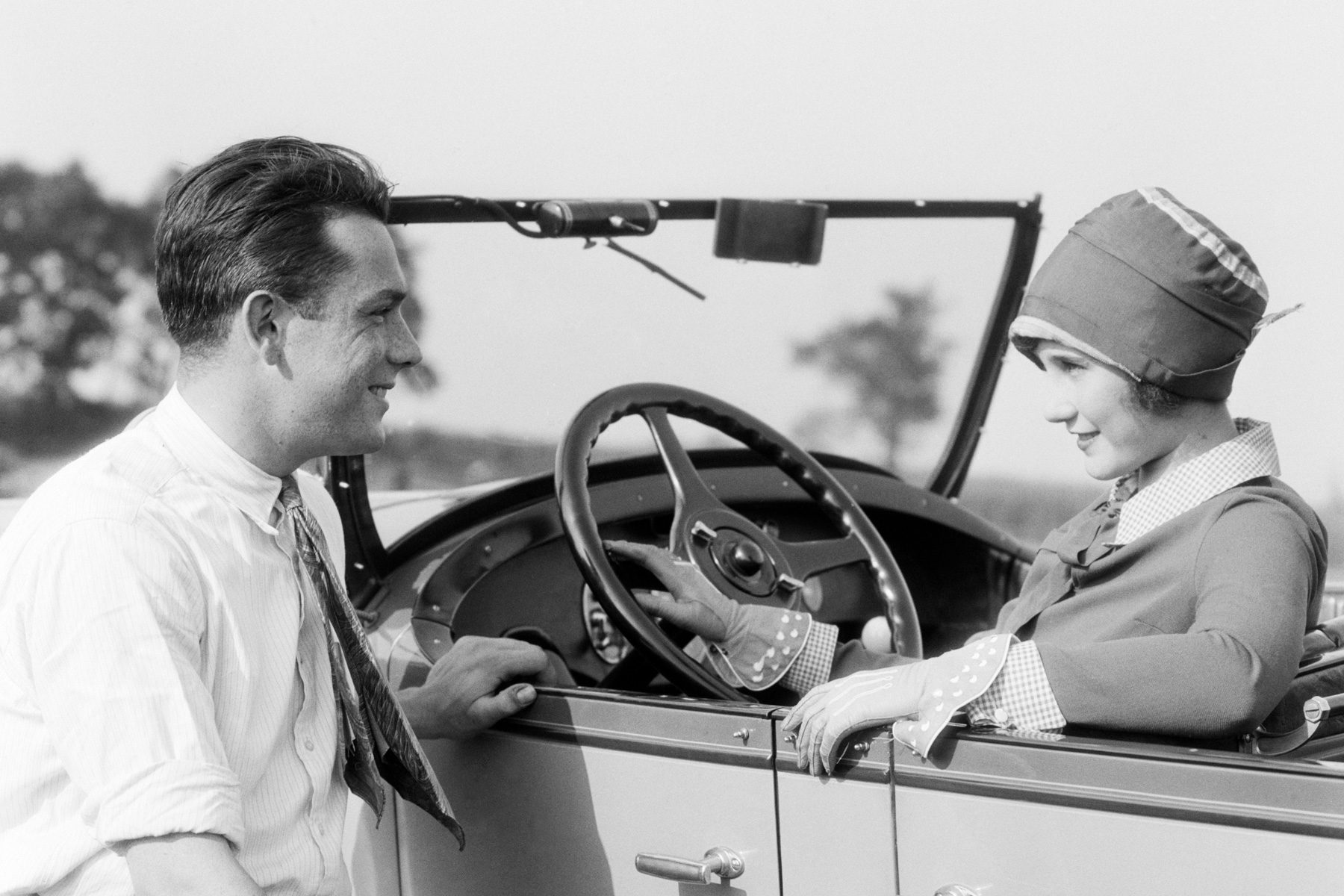These old-fashioned greetings and sayings will add some vim, vigor and politeness to your modern conversations

14 Old-Fashioned Pleasantries We Wish Would Come Back

Why, hello there, old sport! Lovely to see you again, milady! Remember the days of yore when folks greeted each other with a cheery “Top of the morning to ya!” or responded to a query with a cheeky “Just powdering my hair.” No? OK, neither do we. But that’s all the more reason to resurrect these old-fashioned greetings and pleasantries, like a very well-spoken Victorian ghost rising from the dead.
Of course, knowing how to greet someone and have a polite conversation is one of the top etiquette rules. And in a world where “Hey,” “Yo” and “What’s up, bruh?” are the norm, how much fun would it be to mix things up a bit and add a touch of class? So with that in mind, we do declare, with vim and vigor, that it’s time to bring back the flair, the drama and, well, the unnecessary wordiness of the greetings of yore.
Not sure where to start? We got some insights from Cathy Hellier, an expert in historical etiquette and a historian at the Colonial Williamsburg Foundation, and modern-day etiquette experts Jan Goss and Sharon Schweitzer. Read on to find out how to make every encounter feel like the opening scene of a period drama. Bonus points if you can deliver these old-timey compliments with a straight face!
Get Reader’s Digest’s Read Up newsletter for more etiquette, humor, cleaning, travel, tech and fun facts all week long.
“Top of the morning to ya!”
When it was popular: 1800s
This Victorian greeting is another way of saying that you hope someone has the best morning. If you’re imagining a leprechaun popping out to greet you with this cheerful greeting, it’s because this was most popular in Ireland, although it spread throughout the United Kingdom and became a greeting used by many English-speaking people.
If you don’t want to go full 19th century, “telling someone ‘good morning,’ whether it’s a stranger, an acquaintance or a friend, is always a lovely gesture, no matter which polite words you use,” says Goss, founder of Show Up Well Consulting. It’s a common courtesy—and a positive way to get the morning started.
“A good day to you, Sir”
When it was popular: 1600s–1700s
This old-fashioned greeting used to be one of the most commonly exchanged pleasantries, says Hellier. But today, unless someone is sarcastically shouting “And a good day to you!” after a rude encounter, it’s rare to hear someone cheerfully end a conversation with this.
These days, of course, it’s more common to end with a casual “See you later” or simply “Bye” instead of offering well wishes. But we like the flair of this 17th- and 18th-century send-off.
“Greetings and salutations!”
When it was popular: 1800s
Today, you may associate this paraphrase of the adorable introduction that Charlotte makes to Wilbur in E.B. White’s classic book Charlotte’s Web. (To refresh your memory, the exact quote from everyone’s favorite spider is: “Salutations are greetings,” said the voice. “When I say ‘salutations,’ it’s just my fancy way of saying hello or good morning.”) The reason that Charlotte used it? For a century, it was the epitome of a polite greeting.
Can you still use this interesting way of saying hello? Why not! “If you’re unsure what type of greeting you should use with someone, it’s best to err a bit on the side of being a little too polite or formal,” Goss says, who also notes that polite people always offer a kind greeting. “It won’t come across as stuffy or serious if you say it warmly, with a smile.”
“How do you do?”

When it was popular: 1700s–early 1900s
Raise your hand if you did a mental curtsy reading that sentence. If you did, it’s because this is one of the old-fashioned greetings often used in portrayals of royalty or high-class societies of yesteryear, Hellier says. Unfortunately, this formal greeting has mostly disappeared in favor of the casual-but-friendlier “How are you?” or “What’s up?” But we’d love to bring back this polite, formal greeting, often used in English upper-class society, because it brings back a touch of class and civility. As for kissing the other person’s hand while saying it? We only recommend that if you’re very well acquainted with the other person.
“Salve!”
When it was popular: Ancient Rome
Yep, we’re going waaaay back for this one. Pronounced SAHL-vay, this formal Roman greeting was equivalent to “Hello” or “Be well.” The word salve is Latin for “healthy” or “safe,” so it was a quick, polite way to greet people and wish them well. It’s still used in Italy today, and we’d love for it to cross the ocean to become popular here as well. Not only is it short and sweet, but it’s just fun to say! And, as Goss notes, it’s always good to switch things up: “It’s good to have a repertoire of polite pleasantries in your back pocket—it keeps things fun and interesting.”
“If you please”
When it was popular: 1700s–1800s
These aren’t uncommon words today, but we rarely use them in this way. This polite phrase was frequently used in previous generations as a way to soften a request, making it seem like more of an invitation than a demand, Hellier says. Now, people generally speak more forthrightly (and, often, rudely), which is why it would be nice to bring back this polite phrase. “We could all do with being a little more polite in our day-to-day interactions,” Goss says.
“Just powdering my hair”
When it was popular: 1830–1900
Of course, all pleasantries aren’t greetings. And one of the most common pleasantries involves asking someone what they’re up to. In the Victorian era, just like today, people often came up with funny euphemisms to describe their activities. For instance, today you might say you’re “heading to the porcelain throne” if you need to use the bathroom. Similarly, back then, if you replied, “Oh, just powdering my hair,” it meant you were on your way to get good and drunk, according to Passing English of the Victorian Era: A Dictionary of Heterodox English, Slang, and Phrase.
“I crave your pardon”
When it was popular: 1500s–1600s
A sincere apology is a staple of polite society, says Schweitzer, founder of the business-consulting company Access to Culture. This particular pleasantry is an old-fashioned way to ask for forgiveness, with “crave” meaning to earnestly request.
The key with any apology is to convey empathy and trustworthiness. And, Goss adds, “apologizing is not a sign of weakness—in fact, it’s a sign of great character.”
“Not up to dick”
When it was popular: 1830–1900
When someone asks you how you are doing and you’re not doing great, what do you say? In our society that prefers to keep pleasantries rather sterile, you’d probably say something like “Been better” or “I’m OK.” But in the olden days, they got straight to the punch with the colorful “Not up to dick,” according to Passing English of the Victorian Era. But it wasn’t meant to be an offensive word. In this context, dick was British slang for “anything” or “much.” So you would really be saying “I’m not feeling well” or “I’m not in good shape.” Today, you could use it as a funny, if slightly irreverent way, of saying that you’re not feeling well. That’s sure to lighten the mood, earn a few laughs and make you feel better right way!
“My pleasure”

When it was popular: 1900s
You may have heard people say this—or perhaps you said it once upon a time! It used to be common through the middle of the last century, about two generations ago. “This gracious phrase was often used after ‘thank you’ and in conjunction with ‘you’re welcome,'” says Schweitzer, “but it is seldom used today.”
Instead, these days the standard reply to “Thank you” is usually “No problem,” a phrase Schweitzer finds unfortunate. “It’s much too informal and, depending on the tone of voice, may even come across as snide,” she says. Plus, it tells the other person that you might have found their request problematic in the first place rather than being happy to help out.
Let’s bring back “My pleasure” as a way to show that you are happy to have helped someone.
“Mind the grease”
When it was popular: 1830–1900
Today, when you pass someone on a crowded sidewalk, you usually offer a polite “Excuse me” or “Pardon,” but in the Victorian era, a common pleasantry to say the same thing was “Mind the grease,” according to Passing English of the Victorian Era. Why? It was used as a cautionary statement, often given by servants or working-class people to others, to be careful of grease stains or slippery spots. The phrase was a gentle reminder to keep a polite distance and be careful when passing.
“Keeping a polite personal bubble is still good manners today,” Goss says, “and you should always be mindful to give others their space when passing.”
“Well, that takes the egg!”
When it was popular: Late 1800s–early 1900s
What is the proper pleasantry to use to show excitement or happiness when someone shares some good news with you? Today, you might say, “That’s awesome!” or “Well done!” But if you lived in America a century or two ago, you might have said, “Well, that takes the egg!” It meant “That takes the prize” or “That’s the best (or worst) of all” in a situation, similar to saying “That takes the cake” today.
Where did this message of congratulations come from? No one is quite sure, but one possibility is that in early America, a prize egg was often given as an award for winning something, particularly at a fair. It’s such a funny expression that we’d love for it to make a comeback. Plus, it’s versatile! It can be used to express surprise or amazement, or to say something was particularly impressive, absurd or unexpected.
“Pray, how are you enjoying the afternoon?”
When it was popular: 1700s–1800s
People used to exchange pleasantries about their day not just as a social convention but as a way to see how the other person was doing and, as such, would ask more specific questions about their well-being, Schweitzer says. Now, in the day of Instagram and Facebook, it’s often assumed you know how someone is doing and that if you don’t, then you should look it up.
“Today, people use the rote ‘How are you?’ which almost always receives the standard response of ‘Fine,'” Schweitzer says. But because the questioner really doesn’t expect an honest answer, she notes, this pleasantry does nothing to build relationships. Perhaps using this more specific, old-fashioned pleasantry will encourage more authentic connections.
“Your humble servant”
When it was popular: 1600s–1800s
“Signing a letter ‘Your humble servant’ or ‘Your most obedient servant’ were polite greetings among the gentry and middling sorts and originated as a form of gracious condescension,” Hellier says. It was never used by actual servants but rather as a way for one person to show deference and goodwill to a person they saw as having similar or slightly lower standing, she explains.
These days? Most letters are signed automatically with an email signature or a quick “Thanks” or “Love,” but many times they’re not signed at all. Using a variation of this phrase would be a way to show humility, but in a quirky or ironic way.
About the experts
|
Why trust us
Reader’s Digest has published hundreds of etiquette stories that help readers navigate communication in a changing world. We regularly cover topics such as the best messages to send for any occasion, polite habits that aren’t as polite as they seem, email and texting etiquette, business etiquette, tipping etiquette, travel etiquette and more. We’re committed to producing high-quality content by writers with expertise and experience in their field in consultation with relevant, qualified experts. We rely on reputable primary sources, including government and professional organizations and academic institutions as well as our writers’ personal experiences where appropriate. For this piece on old-fashioned greetings and pleasantries, Charlotte Hilton Andersen tapped her experience as a longtime journalist who specializes in etiquette and communication for Reader’s Digest. We verify all facts and data, back them with credible sourcing and revisit them over time to ensure they remain accurate and up to date. Read more about our team, our contributors and our editorial policies.
Sources:
- Jan Goss, etiquette expert and founder of Show Up Well Consulting; phone interview, Oct. 12, 2024
- Cathy Hellier, a historian at the Colonial Williamsburg Foundation and an expert in historical etiquette
- Sharon Schweitzer, modern manners expert, attorney and founder of Access to Culture
- Passing English of the Victorian Era: A Dictionary of Heterodox English, Slang, and Phrase by James Redding Ware























